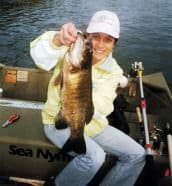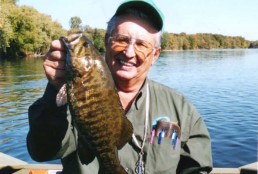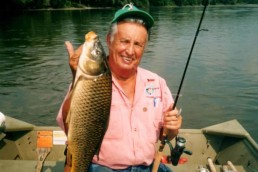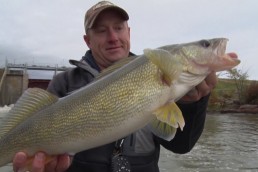Quiet Waters Rise off the Bottom to Harbor River Fish
SHARE THIS POST
Foreword: For about six years, Dan Gapen, the head river rat, and “Bobber” Anne Orth have been hard at work refining their understanding of a river-fishing discovery they made while testing a new lure called the Spin Bee. We are excited that they approached MidWest Outdoors about publishing their work; this is the third of three parts in an exclusive series just for our readers. We are also offering additional coverage of this “Gapen River Zones” concept on MidWest Outdoors Television, on the new MidWest Outdoors radio podcast, on our blog at midwestoutdoors.com, in our free email eNewsletter, and in our social media feeds. This information will change how you fish in rivers. We aren’t aware of anyone else describing what you are about to read, and welcome comments and questions on our behind-the-scenes blog post, at midwestoutdoors.com/gapenzones.
To better understand this new phenomenon we call river zones, we can now name them. We now know that there are two distinct river zones at or relatively close to the bottom.
During the summer and fall of 2015, “Bobber” Anne and I identified an unpredictable and very turbulent zone directly above the slack-water zone at the bottom. This “upper” zone features currents that pulsate from side to side, as well as racing fast up and down.
To help you relate better to these zones, they are named as follows.
- The bottom- hugging zone, where current is very slow or nonexistent, we call the River Benthic Zone, or RBZ.
- The turbulent and unpredictable zone that occurs directly above the River Benthic Zone, we call the River Hydro Zone, or RHZ. We gave it that name because of its erratic currents.
As with the first two articles in this series, I’ve penned drawings to help you better understand this new phenomena. See diagrams J and K.
This research has been performed by underwater cameras, run by my very capable partner, ‘Bobber’ Anne, and that hot little lure, the Spin Bee. It was the Spin Bee, with its flashing tail spinner, that first brought the bottom zones to our attention. The lure was being trolled near river bottom, and observed by the knowing eye of Anne, on her underwater filming gear. When the lure entered a Benthic Zone, the lack of current caused the spinner to stop spinning.
It was also the Spin Bee that alerted us to the Hydro Zone, with its fast and random currents. When the lure would travel through a Hydro Zone, it would get tossed around like a knuckleball, jumping side to side and up and down in 6- to 20-inch rapid jerks.
A tale of two zones
Let’s dive into detail on the second bottom zone we’ve named the River Hydro Zone or RHZ for short.
Do these zones exist in all rivers?
Yes, I believe so. In all the rivers we’ve tested, such as the Wisconsin, Kettle, Mississippi, Pere Marquette, Missouri, Snake, Iowa, and more, we’ve found Hydro Zones.
One interesting finding: this zone varies greatly in depth and its signature erratic currents. It also varies in consistency. In some rivers, the RHZ seems to come and go at will, seeming to disappear one minute and reappear the next. In other rivers, it appears to set up and remain fairly consistent.
We’ve noted when our Spin Bees were lifted out of the Benthic Zone into the Hydro Zone, the Bee would jerk sideways rapidly in 6- to 20-inch movements. Then, when lifted higher, into the main river current (above the Hydro Zone), it would again run normally, with the tail spinner turning perfectly.
Refer again to diagrams J and K.
Let’s go through the three main structures which make up a river.
The River Benthic Zone, or RBZ, holds fast to bottom. Here, our Spin Bee fails to work as the tail spinner stops completely and hangs dead, without movement.
Are you enjoying this post?
You can be among the first to get the latest info on where to go, what to use and how to use it!
In the upper structure, the River Hydro Zone, the tail-spinnered lure jerks erratically about in the side currents in an wild and random manner. Here, at times, the spinner only flops about as the Spin Bee rises and falls, as if up and down currents are being applied. Then that same lure can go into rapid, jerky movements within seconds. One thing is for sure: our observations are that large gamefish, once in the RBZ, don’t like breaking up through it and into the Hydro Zone to pursue a lure. Smaller gamefish, however, will. Note the point marked A on Diagram J.
We’ve observed countless instances when the Spin Bee is holding to one side in the RHZ with its tail flopping rapidly, then stops and is jerked sideways by these erratic currents, as much as 20 inches. Then there can be a rapid jerk up or down or sideways, but never leaving the Hydro zone. We’ve also seen that fish, at times, have difficulty hitting the lure if they try to attack it in this zone.
Finally, as the Spin Bee is lifted out of the RHZ, it begins a pattern in a straight line with tail spinner rotating rapidly. It has now entered the main stream current, the one most anglers are used to fishing.
By looking at diagrams J and K, you will get a good sense for the location of all three river current structures.
Fishing the zones
Determining how these zones should be fished, how fish choose to position themselves when these zones are present, and likely fish reaction to lures is our next topic of focus.
Refer once again to diagrams J and K.
Knowing that the bottom-hugging, slack-water Benthic Zone is always present in the rivers we have studied, Anne and I concentrated on learning more about the Hydro Zone in 2015. How it is created and what effect it has on fish was our focus starting in early July. By viewing dozens of underwater films taken the past three years, we concluded that the Hydro Zone isn’t always present, but when it is it has a profound impact on feeding fish.
With walleyes leaving their spring shoreline habitat and migrating to these zones, we noted large walleyes and large smallmouth bass failing to strike many lures presented above them in the turbulent RHZ. By watching schools of minnows, crawfish, and nymph life in the slack-water Benthic Zone, it seems that most fish have little reason to leave the Benthic Zone to rise up and feed.
Larger fish, noted in diagram J at B and C, have all the food they need right in front of them. Often, schools of walleyes were found holding in the exact position in these river zones for an hour, six hours, and even day after day.

Though fish movement and positioning in these newly-discovered zones were a bit hard to pin down by late August, we had a good idea where they went. Our previous research showed that, year after year, the same zones hold the same type of fish. This goes for rough fish as well. Once, when we had MidWest Outdoors editor Mark Strand with us on the river, he asked how we were able to reference a spot to locate a zone. My answer was simple: “by the large, flat rock on that shoreline.” I’m sure many of you use a GPS these days to return to specific spots.
Conclusions
- Walleyes and rough fish (such as carp and suckers) rarely leave the Benthic Zone, nor do they travel to other positions within a zone. Once they select a spot to feed, they appear to stay in that specific spot. It’s also been noted that very seldom will they exit the RBZ to chase food above them.
- Larger smallmouth bass will travel throughout the Benthic Zone, but they, too, prefer not to leave their feeding zone to travel upward or out of where they’ve selected to gather food.
- Catfish will migrate upstream into the hundreds of smaller zones created where rapids occur. But they always will return downstream to stage in a specific Benthic Zone location.
- Small bass, white bass and all panfish will rise up into the turbulent RHZ to attack lures worked in the Hydro zone. They will also swim up through the RHZ into the smoother, but strong, main river current, in order to take a lure.
- In the Midwest, it would appear that the months of July and August are peak periods when these river zones get larger and have a more pronounced impact on fish location and behavior. Warming river temperature is strongly correlated to this. (For more details on the impact of water temperature on zones, refer to the first two articles in this series, in the January and February issues of MidWest Outdoors.)
- Northern pike and even river muskies use the slack-water Benthic Zones, seeming to choose them as a place of easy rest. Often, we’ve found pike holding flat on bottom with walleyes as neighbors. However, we’ve filmed two incidents where resting pike broke through and out of the zones to attack a lure worked high above, in the main river current.
- Trout species use these two bottom zones in a similar way to small bass and panfish. Trout that stage in the RBZ will bust out through the RHZ and on up through the river’s main current in pursuit of hatching insects.
- Because we have spent countless hours observing the Spin Bee and how fish react to it, we know more about it than perhaps any of our lures. In many cases, we have best success when tipping the lure with a 1/8-inch piece of nightcrawler or something else, such as anise eggs or small minnow head. All species, including carp and various sucker species, are attracted to the flash and vibration of the spinner, and the added scent seals the deal and brings the bite in a lot of cases. For some species, like crappies, walleyes, and white bass, a plain jig with no added scent has been very effective.
Anne and I have much more to learn about these river structures. Maybe the summer season of 2016 will see more secrets divulged. If you are excited by this information, or disagree with me, I’d love to hear from you. You can reach me by leaving a comment at the blog post found at midwestoutdoors.com/gapenzones.
One thing I’ve learned while researching these zone structures is that you’re never too old to learn. I guess that’s what makes fishing such a fascinating sport. Until next time you hear from us, relax, savor, and enjoy our great outdoors. It’s yours to save and protect for future generations.
For more information…
For more river know-how from Gapen, check out the book, “River Fishing, a Happy World,” available at gapen.com.
MWO
SHARE THIS POST
Did you enjoy this post?
You can be among the first to get the latest info on where to go, what to use and how to use it!
Dan Gapen
Considered one of the world’s leading river anglers, Dan Gapen, Sr. has shared his knowledge with MidWest Outdoors readers and viewers for more than 40 years. He is a member of all three Fishing Halls of Fame—International, National Freshwater, and Minnesota. He has an immense grasp of the world’s fisheries. He may be contacted at 877-623-2099.
@TheGapenCompany.



